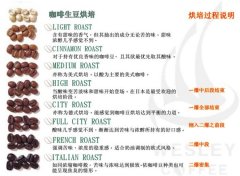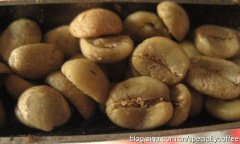Coffee Roasting Equipment Type and Degree of Roasting
Coffee Roasting
Coffee is popular mainly because of the aroma formed after roasting and the taste when drinking. Coffee beans themselves do not have any special taste, is roasted to completely transform and reorganize the internal substances of the beans, forming a new structure, thus bringing out the flavor of coffee.
Baking tools-baking machine, divided into 3 categories: direct fire, semi-hot air direct fire and hot air. The last two are mainstream.
Direct fire: the earliest baking tool used by humans. Disadvantages: slow heat conduction rate of iron; long baking time; waste of hot air; raw beans contact the drum wall for too long, easy to be burnt, resulting in bitter taste and burnt taste; debris in and out of the barrel attached to the surface of coffee beans will turn the flavor turbid.
Semi-hot air direct fire type: 1870 - 1920 German Van Gupen (Van Gupen) improved and manufactured. In 1907, Germany's Perfect baking machine began to apply this concept, using gas heating and a fan to bring half of the hot air into the drum and half to the outer heating drum. So far, Germany's Probat drum baking machine is famous all over the world. In addition, Idaho's Diedrich pioneered the use of gas-activated infrared heat sources in 1987 to make temperature control more precise and become the first brand in North America.
Semi-hot air direct fire type, direct heating of the drum with fire source, while bringing hot air into the drum to increase heating speed, but also blowing away debris, so producing balanced clean coffee beans.
Hot air type, pioneering in the 20th century, roasts coffee beans with hot air to improve roasting efficiency. Jabez Burns Thermalo, a large hot-air baking machine, manufactured in 1934 by Burns Company of the United States.
Fluid-Bed Roaster, which blows green beans up and down with hot air. In 1976, American Michael. Michael Sivetz designed the fluidized bed roaster. Famous Australian coffee expert Ion. Ian Bersten also designed and built fluidized bed roasters. When using this roaster, the coffee beans fall after being blown to a high point, and are roasted again by hot air, so that the coffee beans can be roasted evenly. However, the lack of metal drum smoldering, some people think that one less flavor.
Coffee roasting is a process of pyrolysis, which completely changes the substances inside the green beans, producing new compounds and recombining them to form aroma and alcohol. This effect only occurs at high temperatures.
In fact, roasting is the most difficult step in coffee processing, and it is both a science and an art. The baking process is divided into approximately 3 stages:
Dehydration. In the early stages of baking, green beans begin to absorb heat, and the water inside gradually evaporates. At this time, the color gradually changed from cyan to yellow or light brown, silver skin began to fall off, you can smell the faint smell of grass. The main function of this stage is to remove moisture, which accounts for about half of the baking time. Since water is a good heat conductor, it helps roast the internal substances of coffee beans. So, although the goal is to remove water, the baker will use the temperature of the water well and control it so that it does not evaporate too quickly.
High temperature decomposition, roasting to about 160 degrees, the water in the beans will evaporate into gas, began to exclude the outside of the coffee beans. At this time, the interior of the raw beans changes from endothermic to exothermic, and the first cracking sound occurs. After the first crack, it will turn to heat absorption, at this time, the internal pressure of coffee beans is extremely high, up to 25 atmospheres. The heat and pressure begin to break down existing tissues, forming new compounds that give coffee its taste and flavor. At about 190 degrees, the conversion between heat absorption and heat emission occurs again. Of course, pyrolysis continues to occur, and the beans change from brown to dark brown and gradually enter the stage of heavy roasting.
Quenching: Coffee should be cooled immediately after roasting to quickly stop pyrolysis and lock in flavor. Otherwise, the high temperature in the beans will continue to take place and will burn off the aromatic substances. There are two cooling methods, one is air-cooled and the other is water-cooled. Air-cooled coffee is slow, but clean and pollution-free, and can retain the aroma of coffee. It is used for fine coffee. Water-cooled coffee beans are sprayed with a layer of water mist on the surface of the coffee beans, causing the temperature to drop rapidly, requiring precise calculation, and increasing the weight of the roasted coffee beans, which is generally used for commercial coffee roasting.
Crack sound, raw beans from heat absorption to heat, internal substances discharged from the body, will form a clear sound. The first time was louder, crisp and scattered, and the second time was softer, detailed and concentrated. Because of the high correlation between cracking sound and temperature, it can fully represent the baking temperature, which is an important basis for bakers to judge baking degree.
The changes caused by baking are complex, and although scientists continue to study and analyze them, they still can't get a full picture. Roughly, the changes are as follows:
Weight loss: moisture content from about 13% to 1%, weight loss about 12%~21%, the higher the baking degree, the more weight loss.
Volume Expansion: After roasting, the coffee beans increase in volume by more than 60%.
Cell pore enlargement: the cell wall of raw beans is hard and the cell is empty, so it is not easy to deteriorate. But after baking, the cell walls become fragile, the pores enlarge, and it is easy to lose internal materials.
Carbon dioxide formation: high temperature decomposition causes carbohydrates inside coffee beans to decompose and combine with other substances to form large amounts of carbon dioxide, which resides inside coffee beans.
Changes in tissue structure: After baking, carbohydrates dropped sharply from 58.9% to 38.3%, and acidic substances (fatty acids, tannic acid and chloric acid, etc.) dropped from 8.0% to 4.9%. Under the action of pyrolysis, these substances recombine and transform into caramel, carbon dioxide and some volatile substances. Caramel accounts for 25% of the quality of roasted beans, forming the sweet taste of coffee. Fat, which accounts for 16.2% of raw beans, rises to 17% after baking, which is the source of mellow taste and consistency. Caffeine levels barely changed. The bitter taste of heavily roasted coffee is not due to the high caffeine content.
Baking Degree, Pacific Region Classification:
Light Roast: Still grassy, no aroma and mellow.
Cinnamon Roast: Coffee beans turn cinnamon
Medium Roast: Has a strong sour taste.
City Roast: Sour, bitter and sweet begin to balance.
City + Roast: Roast until the first crack, just before the second crack.
Full City Roast: Roast until the second crack is in progress, a favorite of select coffee roasters.
French Roast: Very bitter.
Italian Roast(Italian Roast): Italian espresso coffee ingredient.
The Specialty Coffee Association of America (SCAA) uses the Elon meter (infrared to measure coffee color and caramel-like coking) to judge and analyze. Set black to 0 and white to 100, divided into 8 equal parts, representing 8 baking grades.
Specialty coffee is roasted differently from commercial coffee:
Roasting methods are determined by the properties of the beans (moisture content, hardness, age, and sample cup testing);
small baking;
The baker looks after the whole baking process (pay attention to the change of temperature and time, listen to the crack sound and observe the change of color and luster);
Deliver at The Same Day Of roasting.
Important Notice :
前街咖啡 FrontStreet Coffee has moved to new addredd:
FrontStreet Coffee Address: 315,Donghua East Road,GuangZhou
Tel:020 38364473
- Prev

Coffee Knowledge Coffee Deep Roast and Light Roast
Deep roast and light roast Simply speaking, coffee beans roast into the second explosion will be called deep roast, one explosion dense to two explosions will be called light roast to medium deep roast, the color is also the deeper the roast and closer to black. First of all, let's talk about deep roasting. When it comes to deep roasting, we must talk about the legendary figure in the coffee world-Alfred Peet. Mr. Pitt worked to promote heavy baking in the 1960s.
- Next

Coffee common sense Coffee roasting process after picking
Generally speaking, coffee roasting is a time-temperature dependent process in which physical changes and chemical reactions occur in raw coffee. Roasting is the last and most important step in the processing of coffee beans after they have been picked. Green coffee beans cannot be used directly to make drinking coffee. All coffee beans must be roasted before grinding and brewing. not
Related
- Beginners will see the "Coffee pull flower" guide!
- What is the difference between ice blog purified milk and ordinary milk coffee?
- Why is the Philippines the largest producer of crops in Liberia?
- For coffee extraction, should the fine powder be retained?
- How does extracted espresso fill pressed powder? How much strength does it take to press the powder?
- How to make jasmine cold extract coffee? Is the jasmine + latte good?
- Will this little toy really make the coffee taste better? How does Lily Drip affect coffee extraction?
- Will the action of slapping the filter cup also affect coffee extraction?
- What's the difference between powder-to-water ratio and powder-to-liquid ratio?
- What is the Ethiopian local species? What does it have to do with Heirloom native species?

